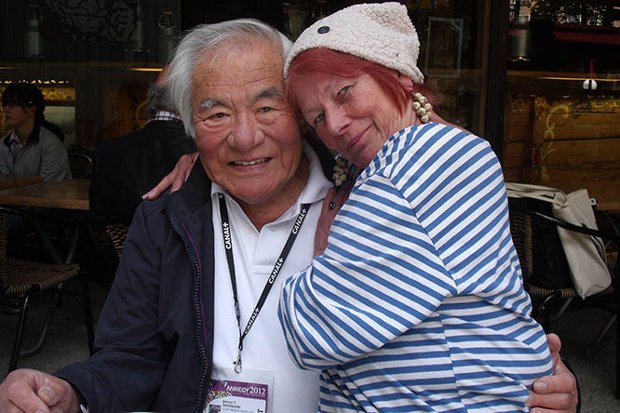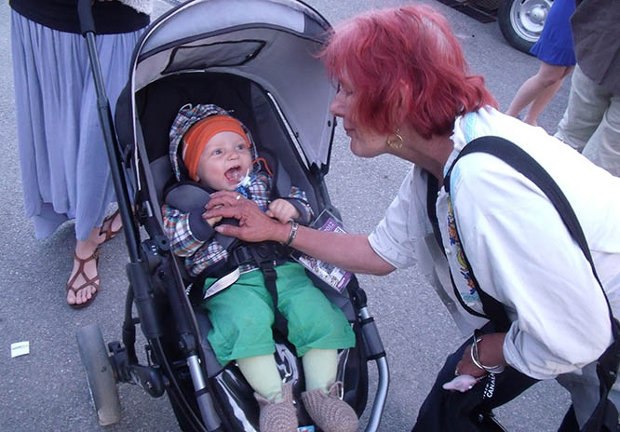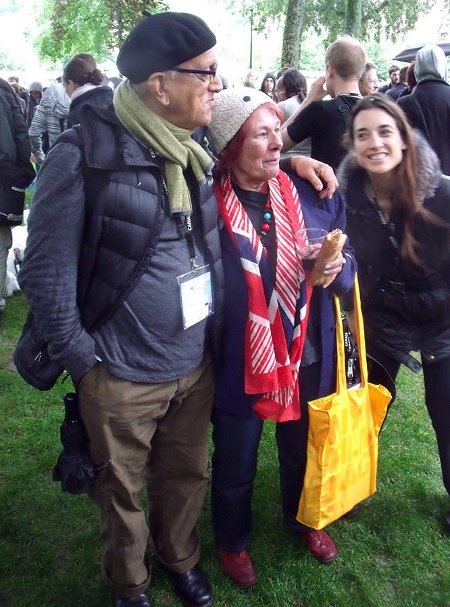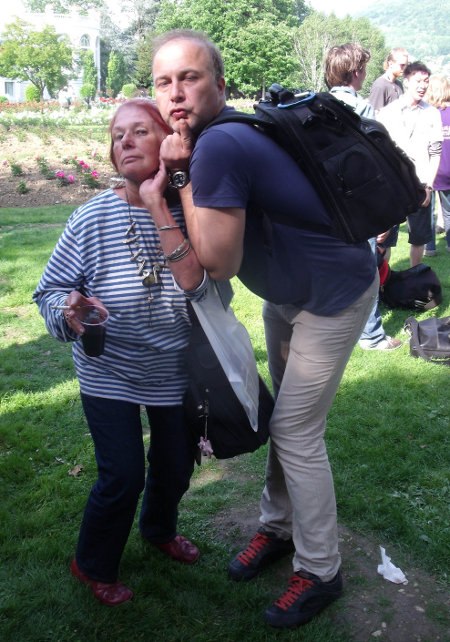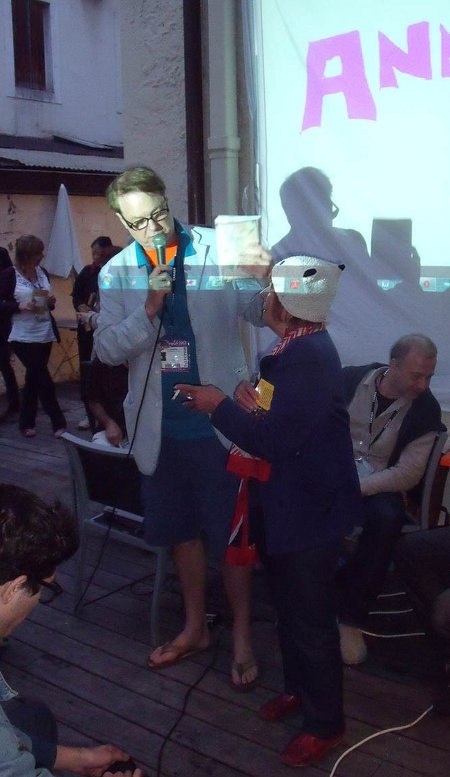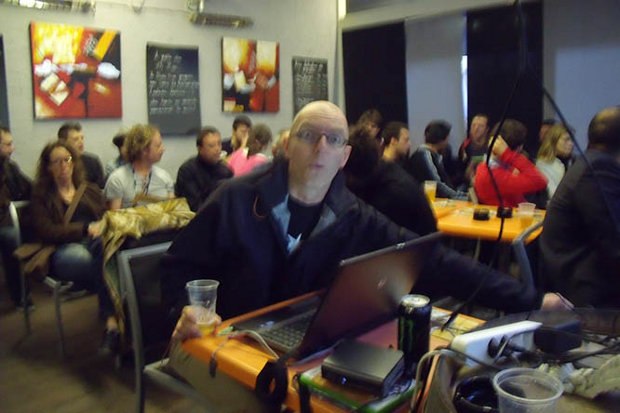Our tireless festival stalwart Nancy Phelps shares her in-depth perspective on this year’s Annecy festival.
I always approach Annecy with mixed feelings. On the one hand it is an opportunity to see so many dear old friends from all over the world, along with special programs that won’t screen at any other festival, but over the past few years it has become very commercial and shifted the emphasis away from short, independent animation to feature films. With over 7,000 people attending the festival it has become harder and harder for people to get tickets to screenings that they want to see, and if you don’t book a room very early you could end up staying miles from the festival. This year, in spite of many potential difficulties, I did enjoy myself.
The big news of the week wasn’t about film per se, but was Serge Bromberg’s closing night announcement that after 14 years as Festival Artistic Director he is passing the artistic baton to Marcel Jean. Serge wants to concentrate his efforts on his production company, Lobster Films which finds and restoring classic films such as his recent efforts in restoring missing footage to George Milies’ 1902 film A Trip to the Moon. He did say that he “would see us all next year because I already have my ticket to the 2013 festival”.
The new Artistic Director, Marcel Jean, is a Canadian producer, director, and author who is probably best known as the producer of the 2009 short Sleeping Betty. He has promised to “shake up a few habits and offer festival goers a host of surprises”. Marcel is a familiar face on the festival scene and I think he will do an excellent job.
For the past few years I have felt that the selections in the Short Film Competition have been lacking, with many of the best films relegated to Out Of Competition programs or even worse, rejected all together. This year the concept of an international selection jury was replaced by the three man team of Laurent Million, Yves Nougarede, and Sebastien Sperer from the Creative Content department of CITIA. I am pleased to say that they did a very good job and that the 5 programs of the Short Film Competition were by and large very strong.
I was very impressed by the great British puppet animator Barry Purves’ Tchakovsky, An Elegy. The beautifully crafted Tchaikovsky puppet was so life like that I almost forgot that I was watching an animated film. The attention paid to even the smallest detail of set design was a delight to the eyes. The film is based on Barry’s adaptation of Russian producer Irina Margolina’s Tchakovsky’s Letters and is one of a series of animations about composers produced by the multi-talented Margolina.
Another puppet animation that moved me was Danish director Johan Oettinger’s Seven Minutes in the Warsaw Ghetto. The story of an 8 year old Jewish boy living in the Warsaw Ghetto during World War II is based on a true event. As hungry Smaek struggles to pull a carrot through a hole in the Ghetto wall, he is unaware of the two SS men on the other side following his every move. The tragic climax of the film is intensified by stark black and white and the absence of dialogue. Seven Minutes in the Warsaw Ghetto won a special mention from the short film jury.
The shorts competition was also full of delightfully humorous films. Chinti by the very talented young Armenian director Natalia Mirzoyan made me smile. I will never think of an ant in the same way again after watching this small ant try against tough odds to fulfil his big dream to build a miniature version of the Taj Mahal after finding a picture of the magnificent structure. Natalia used different colors and textures of tea along with 2D computer techniques to create a unique visual effect. Unfortunately, the quality of the projection for this film on the big screen at the Bonlieu theatre was not sufficient to show the beautiful textures and colors of the tea that can be seen on the DVD version on a smaller screen. Instead it looked like rather bad computer animation.
US animator Matthew O’Callaghan’s cartoon took me back to my childhood when a trip to the movies always included a wacky short. In Daffy’s Rhapsody, Matthew was inspired by the early 1950’s recording of Daffy’s Rhapsody, an old Mel Blanc song which was never animated. He used Blanc’s original voice while creating a story around the song.
Elmer Fudd goes to the theatre and is surprised to find Daffy Duck on stage singing about the woes of always falling prey to hunters who shoot at him. In true Elmer style, the urge to grab his gun and pursue Daffy is just too strong. Throughout out the ensuing chase scenes Daffy sings on while trying to avoid the blasts from Elmer’s gun. I’m usually not impressed with the current trend toward 3D animation but for once I actually forgot that I was wearing the glasses because the effect really enhanced the chase scenes.
PES’s Fresh Guacamole follows in the footstep of his clever films that use familiar foods, household items, and found objects as he gives us a cooking lesson. This time PES shows us how to make guacamole in his own inevitable humorous fashion.
Sunny Afternoon by Austrian animator Thomas Renoldner is his analysis of avant-garde film and music video genres that explore taboos and clichés. Thomas, a great champion of avant-garde film, first started this film 20 years ago and finally finished it this year. When not making films, curating festivals, teaching and writing books, Thomas has put together a new DVD, Animation Avant-Garde DVD 01. The DVD features films by such renowned animators as Andreas Hykade, Signe Baumane, and Max Hatter as well as upcoming young talent. You can find a complete list of the films and animators along with how to order this excellent collection at
Czechanimator Michaela Pavlatova has always been in the forefront of showingsexuality from the female point of view. A new film full of herwickedly sardonic humour is always a treat. Her latest erotic work Tram takes us into the fantasies and urges of a female tram driver whoseimagination transforms reality into a surreal and phallic delirium. TheShort Film jury shared my delight in Tram and awarded it the AnnecyCristal, the top prize of the festival. Michaela also received a secondhonour by capturing the Fipresci Award given by the International Federationof Film Critics.
Ihad already seen several of the 10 feature films in competition and the 15that were screened out of competition, but there were a few newsurprises. Argentina has a long, rich history of animation, but for fartoo long South American animation has been virtually unknown to most of theworld. This is beginning to change and two of my favourite featurefilms at the festival were from South America. The Argentinean/Spanishco-production Anima Buenos Aires is made up of four separate storiesby four different animators and delves into the heart and soul of thatglorious city as it faces up to the onslaught of globalization. Thevignettes of Buenos Aries life are set to the strains of tango, evocative musicof Argentina.
Isaw a “work in progress” of the film last year and it really lived up to myexpectations. I particularly enjoyed the first piece Pissed by Dogs animatedby Florence and Paul Faivre. The story of a local butcher who is losinghis customers when a powerful large chain market moves into his neighbourhoodis an unfortunately all too familiar story. Pablo Rodrigues Jauregui’s Cloustropolis is a love story between two older children. A naive, shelteredyoung boy falls in love with a street wise girl who spends her day creatingbeautiful graffiti all over the city. The 4 pieces are linked togetherby the animated stencilled tango dancers that perform all over thecity. They were created by the award winning animator Juan Pablo Zaramella(Luminaris, Lapsus etc.)
Selkirk,El Verdadero Robinson Crusoe (Selkirk, The real Story of Robinson Crusoe) wasa delightful surprise. The almost true story of the castaway whoinspired English writer Daniel Defoe is a Uruguay/Chile/Argentineanco-production directed and animated by Walter Tournier fromUruguay. The stop-motion puppet animation is based on the trueadventures of Scottish privateer Alexander Selkirk who was marooned on anisland in the uninhabited Juan Fernandez archipelago off the coast of Chile. Today the island is known as Robinson Crusoe Island. The story is knownby every Scotsman and I was told that it is also very popular in SouthAmerica.
Thefilm is designed for young children but with a good script and excellentpuppets it is a film the entire family can enjoy. It’s exciting to seea well made film from Uruguay and proves that with a good script and talentedpeople, you don’t have to have a big Hollywood budget to make an entertainingfilm. Both of the South American productions were screened out ofcompetition.
Narratedfrom beyond the grave by the title character, Crulic – The Path To Beyond isa true story of the life and final days of a Romanian immigrant falselyimprisoned in a Polish prison. Rulic died in prison while on a hungerstrike protesting his innocence. Director Anca Damian combines handdrawn images, collage, stop motion, and cut out animation to tell a tragicstory that is beautifully written and visually powerful. Crulic –The Path to Beyond was given the Cristal for Best Feature Film.
Iam also very happy that Arrugas (Wrinkles,) Spanish director IgnacioFerreras’ frank film about Alzheimer’s received a Special Distinction Awardfrom the jury. Producer Manuel Cristobal told me that the film willsoon be released in United States and France.
Unfortunately,like many other animators and members of the press I did not get tickets forthe opening night screening of Patrice Leconte’s latest film The SuicideShop so I can’t tell you anything about it. John Kahrs’ short Paperman produced by Walt Disney Studios also played on opening night so onceagain I can’t say anything about the film. It is a shame because theywere both films that I was looking forward to seeing.
Asthe festival has grown in size over the past few years, the problem ofanimators and the press not receiving tickets for the opening night ceremonykeeps getting worse and worse. These are the very people who deserve toand need to be there the most. Animators work long and hard to create afilm and for most of them, unless they are very lucky, their biggest rewardis to have their work screened at a festival. A ticket to the openingnight screening is a small but important reward for their efforts.
Mostmembers of the press spend their own money to attend Annecy, a very expensiveresort city, to write about the festival. This is not a holiday, we areworking very hard. If we can’t see a film or be at a major party orevent we can’t report to our readers about it. Nik and I did receiveinvitations to the pre-opening Mayor’s Reception and the opening night partyat La Plage however.
The Mayor’s Reception is a small gathering at the beautiful Hotel d’Ville (City Hall) with members of the juries and special guests. It is an excellent time to chat with old friends before the crazy rush of the festival begins.
This year Annecy saluted Irish animation, so the reception was a lovely chance to catch up with my friend Darragh O’Connel who would be kept busy all week on the Short Film Jury. Darragh, co-founder of the Dublin based Brown Bag Films, is a two time Academy Award nominee for Give Up Your Aul Sins (2002) and Granny O’Grimms Sleeping Beauty (2010).
Forty Frames of Green showcased 57 Irish animated shorts in four programs covering a wide range of styles and topics spanning the countries animated history from the 1930’s 3 minute Miclin Mac to the most contemporary work. One program was devoted to imprisonment, a recurring theme in Irish animation, from psychological captivity to physical oppression. Tom Moore’s beautiful feature film The Secret of Kells, a lovely story about Ireland’s national treasure The Book of Kells was also shown.
The big treat for me however, was to see When the Wind Blows. Jimmy Murakami uses irony and absurdity to illustrate the danger of ignoring the horrors of nuclear war in his portrayal of a British couple who live in the countryside and choose not to worry about the possibility of armed missiles landing around them. Many people consider this 1986 feature film to be one of the greatest animated anti-war statements along side of Norman McLaren’s powerful Neighbors. Although When the Wind Blows never received a theatrical release, it was awarded the Annecy Feature Film Crystal in 1987.
Annecy has always been very good at honouring elder statesmen animators past and present. The Big Sleep pays homage to those creative talents that left us in 2011. Nobruhiro Aihara, Karen Aqua, Vincent Joseph Cafarelli, Zdenek Miller and Jean Giraud (Moebius) are gone but they certainly will never be forgotten by anyone who loves animation. I like to think that the heavens are a bit more colourful and bright now that these five talented creators are up there shining down on us.
It’s always lovely to give thanks to a remarkable animator while he still with us. The delightful Danish animator Inni Karina Melby worked closely with the festival to pay homage to the renowned Dutch animator and jazz musician Borge Ring. Borge is over 90 years old and no longer travels, but his daughter, Anne Micke Bovelett-Ring, introduced a screening of his work with some humorous and touching reminisces about her father. Following Anne’s words Ring appeared on the screen in a video introduction to give us his own greeting.
It has been quite a while since I have seen his films on the big screen but the 1985 Academy Award winning Anna and Bella is as delightful as when I first saw it. The film touches on a wide range of emotions in only 7 1/2 minutes as two elderly sisters relive the past over a photo album and a great deal of red wine.
Oh My Darling, nominated in 1978 for an Academy Award, follows the changing relationship between a daughter and her parents as she grows up and leaves home to start her own family. A great source of delight to her parents, she goes from being a baby in the womb to young woman becoming a mother herself in a mere 8 minutes.
His most touching and personal film is Run of the Mill produced by Borge and his wife Joanike. It is the sad story of a young man who grows up in a happy home but falls prey to drug use. A drug dealer uses the young man’s curiosity about drugs to draw him deeper and deeper into the world of addiction. As their son retreats into his own world, as though enclosed in a bubble, his parents aren’t able to penetrate the bubble and are forced to stand helplessly by and watch the tragedy unfold.
In February 2012 a devastating fire swept through Joanika and Borge’s home, destroying their lifetime of memories including his Oscar, which melted in the blaze. With characteristic humour and panache the Rings choose not to look back but to move on into the future.
Borge is also well known outside of the animation community as a professional jazz guitarist, performing with violinist Sven Asmusses. Sven is well into his 90’s and known as the fiddling Viking. Ring has appeared on the Jazz Behind the Dykes record series as well as with a host of other jazz greats.
This year Ring was honoured at the Annies with the Windsor McCay Award. The award is given to honour career achievement and lifelong service to animation. I can’t think of a more fitting recipient. Watching his films they are as fresh and topical as when they were made. You can read more about his remarkable life and see his films at
TheNational Film Board of Canada is renowned for the high quality of the filmsthey produce. At their press reception they gave us a preview of theirfour films in competition and two in panorama as well as a look at new filmsin production.
ReginaPessoa’s previous film Tragic Story with a Happy Ending won the AnnecyCrystal in 2006 so I was looking forward to seeing her latest work Kali lepetit vampire which is co-produced by France, Portugal, Canada andSwitzerland. Her dark story of a very unusual boy trying to find hisplace in the world takes several viewings to begin to appreciate because itis a very complex film. The story is told by an aged Kali as heremembers the day he finally made peace with himself. Kali le petitvampire, third in Regina’s childhood tales trilogy, is narrated by OscarWinning actor Christopher Plummer.
The NFB has the only Alexeeieff-Parker pin screen still in use. Michele Lemieux, inspired by a workshop given by renowned pin screen master Jacques Drouin, has made the first animation using the screen which had sat idle after Drouin’s retirement. When I asked her why she had chosen this technique to create Le Grand Ailleurs et Elsewhere (Here and the Great Elsewhere) she said that she was fascinated by the painstaking skill and concentration required to work with it. The film is a mischievous, abstract look at the profound reflections of every man and the eternal quest for meaning.
Franck Dion added to the long list of award winning NFB films when his film, Edmond Etait un Ane (Edmond Was A Donkey) received a Special Jury Award from the Short Film Jury. His film delicately probes the eternal issue of being different versus social conformity using 2D/3D photos and the computer.
Many of the films created at the NFB are still made on 35 mm film which is one of the reasons that they look so beautiful on the big screen. Unfortunately the sound on the 35mm projector at the Bonlieu was not functioning properly and the sound was way off. It was most noticeable during Bydlo directed by Patrick Bouchard. The film was inspired by the fourth movement of Russian composer Modest Mussorgsky’s Pictures at an Exhibition so the music was an integral part of the film. It’s hard to believe that a movie theatre like the Bonlieu would have a projectionist that does not know how to properly operate a 35mm projector and I’m afraid that it is a sad commentary on the state of the art of film projection.
I asked the NFB if they knew exactly what caused the problem and Monique Simard, Director of the French Program said, “We are still waiting to receive the copy of the film Bydlo (Patrick Bouchard) sent by the NFB to the Annecy Festival for the required technical checks. Other films co-produced by the NFB, such as Edmond Was a Donkey and Kali the Little Vampire, were submitted by our European co-producers. The Festival has been very helpful in investigating the cause of the problem.
One thing is certain: we are forced to acknowledge the hegemony of the DCP format to the detriment of 35mm this year at Annecy. The vast majority of films were screened in digital format and very few in 35mm. This is a very recent reversal, as it is well known that the Annecy Festival had always been the great defender of 35mm distribution. Lastly, it is the choice of the distributor, and not of the Festival, to release films in DCP, a trend that has grown over time. The NFB chose to distribute Bydlo in 35mm format.”
Attending Annecy means you will have a very busy week. With over 500 films screened over the 6 days of the festival it is impossible to see everything, much less attend all of the special events and presentations. Annecy is also Work in Progress sessions, conferences, Television and Commissioned Film Competitions, and Making Of Presentations and MIFA.
No trip to the festival would be complete without a visit to MIFA (International Animation Film Market). Begun in 1985 MIFA has become one of the major meeting places for industry professionals. This year producers, buyers, and distributors from 61 countries, with first time delegations from Russia, Taiwan, South Africa, and Brazil, showcased their latest productions and works in progress.
As MIFA continues to expand new services are added every year. For 2012 a special screening room was available for presentation of projects and productions as well as a lounge set aside for software demonstrations. MIFA is a world of its own and I see friends there that never make it around the lake to the rest of the festival so the chill out lounge is the ideal place to sit and find out about what their new projects are.
Annecy is not all about screenings. There are plenty of parties which give ample opportunities to catch up with old friends and make new ones. It was delightful to meet Bozidar Zecevic from Serbia who was a member of the FIPRESCI –International Federation of Film Critics Jury. Bozidar is a fellow journalist and he sits on the ASIFA International Board with me but we had never met face to face. We have a mutual close friend in Serbia so it was especially wonderful to get to know this delightful gentleman.
Every year I look forward to the German Reception co-sponsored by MFG Filmforderrung Baden-Wurttemberg, the Stuttgart International Festival of Animated Film, FMX, German Films, and the German Short Film Association. Tuesday afternoon, a lucky group of guests was taken down the lake to a lovely restaurant where there was a sumptuous array of food and plenty of drinks. Dining under the big shade trees lakeside is a wonderful opportunity to relax for a couple of hours away from the crazy rush and crowds of the festival.
The organizers of the Stuttgart Festival are always so busy that there is very little time to visit with them during their festival so this is the ideal time to catch up on all of their news. At the picnic we learned the exciting new from Uli Wegenast, festival co-director, and his wife are expecting twins. The Annecy+ Band, Nik Phelps, Rolf Bächler, Alexei Alexeev, and Veljko Popović provided music for us.
After the German reception, we rushed up to La Plage for the Disney barbecue, and finally got to see old friends Vilnis Kalnaellis and his son Reinis of Riga Films. It was out first chance to meet Reinis’ young son, who wore an official festival badge in his pram. As third generation of a Latvian film family he was definitely the youngest registered festival attendee.
Wednesday we attended the Swiss Film Commission Cocktail Party, where I got to meet Rebekah Villon, ASIFA International Board member from Portand, Oregon. It was wonderful to put another face to the ASIFA e-mails that I receive.
Each year Shelly Page, Head of International Outreach at DreamWorks is the “hostess with the mostest” at the DreamWorks picnic. Rain didn’t dampen our spirits as we all ate and drank under umbrellas. I was delightfully surprised to see my old friend Leo Hobaica, Assistant Dean of the School of Visual Arts at Cal Arts in Valencia, California. When Nik and I lived in California we were invited to Cal Arts every year for their career day and the screenings of the student graduation films where we became friends with Leo. I had not seen him in many years so it was a pleasure to meet again.
This year, the festival screened two programs of Cal Arts alumni, tracing the school’s history from its founding in the 1970’s to the present. The legendary Jules Engles founded Cal Arts Experimental Animation program and was mentor to several generations of animators. His influence young Cal Arts students was very evident in the two programs screened.
Thursday is always a full day of parties and not for the faint of heart. We began in the early afternoon at the Nordic Party on the lawn outside the Hotel Imperial where wine and aquavit flowed. From there we went on to the Dutch Party at the Cafe D’ Artes which has become the popular place to meet everyone in the evenings. From there we went to the Croatian reception before we ended up back up at the Hotel Imperial for the Finnish party. Every year the Finns go all out, building a sauna on the lake shore where we can sweat out the long day of partying.
Friday we had time to drop by the Japanese reception before we had to rush off to a delicious lunch with representatives of the Taipei Film Commission at the Moon Restaurant in La Plage. I had almost no knowledge of Taipei’s active animation community so it was interesting for me to learn about their thriving industry. For many years most of the work I saw from Asia, with the exception of Japan, was very mediocre but in the last couple of years I have seen some very impressive independent works coming from that part of the world.
Friday evening, Bill Plympton and I hosted our annual Annecy+ screening of works that were rejected by Annecy but that we thought were good and deserved to be seen. The evening started with the Annecy+ Band playing to an overflowing crowd on the patio of le Code Bar.
Our four programs were packed with strong films and the audience vote for the three top films was very close. They selected Patrick Schoenmaker’s The Itch as the favourite of the evening, followed closely by Murphy Was Here by Geoffrey Armfield. Third place was garnered by Ornana Film’s Notes On Biology.
Special thanks goes out to our stalwart projectionist Jonas Raeber and to Carole Martinato who lives in Annecy and took care of booking the venue, creating beautiful posters, very impressive programs and so many other little details that Bill and I cannot do because we don’t live there. Also, big congratulations to Carole on her beautiful new son who I finally got to meet.
After rain off and on all week, Saturday dawned sunny and beautiful for the 11th Annual picnic, rounders game, and paddle boat race that Nik and I host on the lawn beside the lake. After days of rushing around to screenings and social events it is so nice for us all to get together to relax, eat, drink, and play games.
The rounders game was started by Joanna Quinn several years ago. I still don’t understand the rules but everyone who plays it has fun. Several members of last year’s winning team were there to defend their title. Sadly Joanna was not at Annecy this year because she is back in Whales finishing up her new film, but she sent a trophy, a bottle of champagne and warm greetings to the winners via Jamie Badminton of Karrot Studio in London.
The paddle boat race was a wacky chase around the island a-la Keystone Cops in boats. Nik and the band stayed on land and played music while I got to ride on the back of a boat full of good strong young men. They came to the race very prepared with water pistols for all of us to fend off the competition.
With Serge’s farewell and confirmation that the Bonleiu will be torn down this year the closing ceremony was particularly nostalgic. After the ceremony it was back off to the now empty MIFA tents for the closing night party.
Aside from the problem with opening night tickets that many of us had and the sound on the Canadian films it turned out to be a good Annecy for me. With a new director and no Bonlieu as a festival center Annecy 2013 will be an adventure full of changes.
See you all next June in Annecy!!!
--
Nancy Phelps has produced music for animation for the past 16 years. She has written about animation and animation festivals for such publications as Animatoons, Film/Tape World, Reel World and the ASIFA/San Francisco news magazine and is a member of the ASIFA International Board. In 2006, Nancy and her composer/musician husband Nik Phelps moved from San Francisco to Gent, Belgium, where they now have their home. Check out her blog here.


